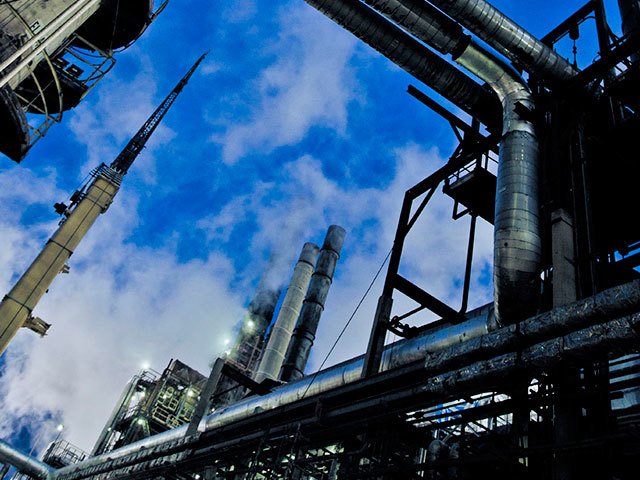
Oil’s slump has almost doubled the value of India’s big, state-owned refiners, outpacing the rest of the industry from China to the US.
The companies had been forced to make a large proportion of sales at below cost for over a decade.
Now, they can profit from fuels after India’s new government saw its opportunity in falling oil prices to deregulate the market without bothering its inflation targets. OPEC’s decision to sit on its hands in the face of an oil glut has only accelerated share gains.
India’s big three state refiners — Indian Oil Corp. (IOCL), Bharat Petroleum Corp. and Hindustan Petroleum Corp. (HPCL) — are up 53%, 84% and 131% respectively over the year to December 24.
Hindustan Petroleum is the best performing oil stock in the world.
For comparison, Asia’s biggest refiner, China Petroleum & Chemical Corp. (386), is down 1.4%, while the largest U.S. processor, Phillips 66 (PSX), has lost 6.5%.
Whether India’s refiners can maintain their tear will depend on the constancy of politicians and markets. In the meantime, there’s a new-found freedom to make money.
“The fuel price deregulation definitely has both an immediate and long-term impact on the Indian refiners,” said Indian Oil’s Finance Director Arun Kumar Sharma. “It improves cash flows and gives a sense of more flexibility.”
India’s refiners have to mostly import their oil to turn it into petroleum products. In the case of diesel, which accounts for almost half the fuels consumed in India, the selling price was below the cost of production to deliver on a government mandate to keep energy cheap and inflation low.
That changed in October, when the government ended price controls.
The companies continue to sell cooking fuels such as kerosene and liquefied petroleum gas below cost, in a country where about a third of its 1.2 billion citizens live on only a few dollars a day.
The global refining industry has done better from oil’s slump than other energy businesses because of lower input costs.
It’s a different story if you drill for oil. Russia’s OAO Rosneft (ROSN), the world’s biggest publicly traded oil producer, has lost about half its value this year in London trading. Exxon Mobil Corp. (XOM), the world’s largest oil company by market capitalization, is down about 7.3%.
Since June, when oil began to slide, analysts covering India’s refiners have become more bullish. Indian Oil and Hindustan Petroleum’s average ratings are either at or near the year’s highs.
China’s refiners have gone the other way, because they’re still obliged to follow state controls on pricing. China Petroleum’s rating is at a six-year low while PetroChina Co., Asia’s biggest oil company, has its worst rating in 18 months.
Asia’s biggest emerging economies are diverging in other ways.
Oil prices at a five-year low are presenting India’s newly elected Prime Minister Narendra Modi with the prospect of rising growth even as China slows.
Inflation has eased, the current account deficit has narrowed, and Modi is winning plaudits for pro-business policies after years of stagnation.
Still, some investors think India’s refiners, their profits dependent on government policy, could already have seen the best of their run.
“There aren’t any fresh triggers now to take it to the next step,” said Vaibhav Sanghavi, managing director of Ambit Investment Advisors Pvt. in Mumbai, which oversees about $150 million. “There are no immediate and short-term catalysts for the shares. What exists now are some other risks.”
In 2002, the last time Modi’s Bharatiya Janata Party held power, the government freed gasoline and diesel prices after Brent crude dropped 17%.
By the middle of 2003, the controls were back on as federal elections approached and oil rose. Brent gained 52 percent between 2002 and 2003.
If this year’s oil’s slump has again given the BJP the opportunity to deregulate, the test of that policy will be when oil prices start going back up, said P. Phani Sekhar, a Mumbai-based fund manager at Angel Broking Ltd.
“I’m not sure if government policy will remain,” said Sekhar. “Everything depends on the pressures of the budget, politics and oil prices. There’s no precedent to show the opening of the oil economy will continue.”
Both fund managers said they don’t own shares in the state refiners.
Indian Oil’s Sharma said crude’s sustained level in recent years of above $100 a barrel has left consumers more resilient to higher prices.
He sees a turnaround in government policy only if “something drastic happens.” That could include a major reversal in Modi’s polling with the electorate, or a spike in oil that approaches the record levels seen in 2008 when it hit $147 a barrel.
Brent crude traded in London has averaged $100 a barrel this year, the weakest price since 2010, with a low of $59 a barrel hit this month.
Prices will rise to $77 a barrel next year and $85 a barrel in 2016, according to the median of 34 analyst estimates compiled.
Recommended for you
